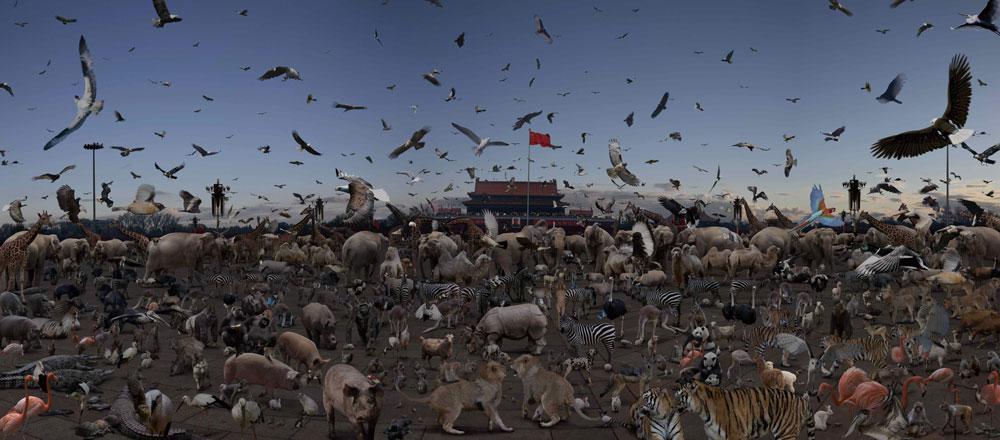“Like Thunder Out of China,” the first exhibition in Arsenal Montreal’s new permanent exhibition space, certainly wields a powerful force. Featuring 18 contemporary Chinese artists and artist collectives and 44 works in total—including paintings, drawings, photographs, videos and a sculpture—the show conveys political edge, as well as considerable technical skill and aesthetic pleasure.
According to co-curator Pia Copper—a Paris-based curator and publisher who has lived in China—the Chinese government can block art exports, so most artists get their work out of the country by either carrying it with them or by making digital art that can be printed elsewhere.
Not at all subtle is the one sculpture in the show, Miss Mao No. 3 (2006), a large stainless steel piece by the Gao Brothers. The government confiscated previous versions of Miss Mao (depicted as a young Manchu prince/princess with braids, huge breasts, a Pinocchio nose and the teeth of a vampire), says the show’s other co-curator Margot Ross, a Montreal art consultant who pitched this exhibition to the Arsenal.
Three artists who might be considered apolitical do have large paintings and drawings in the show.
Qiu Jie crams figures and writing into what resemble overcrowded—but clean and readable—political posters in a Pop-art cartoon style, using only charcoal and a little gouache on paper. Mao—a variant of the name can be translated as “cat”—is portrayed in Woman and Leader (2008) as a feline in a lineup of serious male humans that includes Stalin.
Qiu Jie is more painterly in other charcoal drawings, but just as ambiguous. Mao in Winter (2011) shows the leader as a kind of a foppish post-hippie, again with a cat’s head.
Cang Xin makes charcoal self-portraits full of symbols of his spiritual quest on 650-centimetre-tall scrolls. He’s not overtly political, Copper says, but he believes that “if your being is in perfect order with the universe, the political order will also be in order.”
Gao Xiang paints beautiful-but-grim women and tiny men in Mao suits—a reference to officials—against a Chinese-red background. The artist, who came to Montreal for the opening, denied there is any political intent or symbolism in the work, calling himself a romantic. But he says he is disturbed by the imbalance in relations between men and women in Chinese society. He showed me a catalogue in which he juxtaposes his Who is the Doll? series of paintings, on view at the Arsenal, with photos of historic artworks in which men tower over their women. “Look,” Gao says, “the women are always smaller.”
The emasculated man reappears in Chang Lei’s Sanguinolency of Chinese Civilization No. 2 (2012), naked and sexless. Chang Lei, who was also present at the opening, says it is a self-portrait in which he represents the Chinese male as “without balls.” The elephant—he says that the term for this animal is pronounced in Chinese in a manner similar to the word for “reality”—dominates the background. It has a huge, vulvic mouth.
Again, the work doesn’t aim to promote misogyny. Rather, it is meant to refer to the lack of control that Chinese people have over their lives.
Chang says he is not afraid to criticize the government, but implied that it’s useless to do so. “The government has the control,” he says. “I’m not afraid to show my work in China, but the government can close an exhibition.”
Pornography is the excuse the government uses to censor the Internet, Copper says. He Yunchang’s photograph Ai Weiwei Swimsuit Print (2011) is a group portrait of men and women covered only by printed images of Ai Weiwei, the country’s best-known dissident artist, who has spent time in prison.
Zhang Huan writes his family out of history in a series of photographic self-portraits titled Shanghai Family Tree (2008). Zhang, whose family was blacklisted during the Cultural Revolution, had three calligraphers write texts about the “spirit of family” on his face, Copper says. As the faces turn black with calligraphic marks, apartment buildings appear in the background, marking the transition from village to city.
But there are stirrings of revolt. In Animal Farm (2009), a digital print, Chang Lei puts Communist leaders past and present on a reviewing stand. They preside over a parade ground crowded with animals—all of them in a state of alert.
“Animals sense an imminent change in the weather before humans do,” Copper says.









